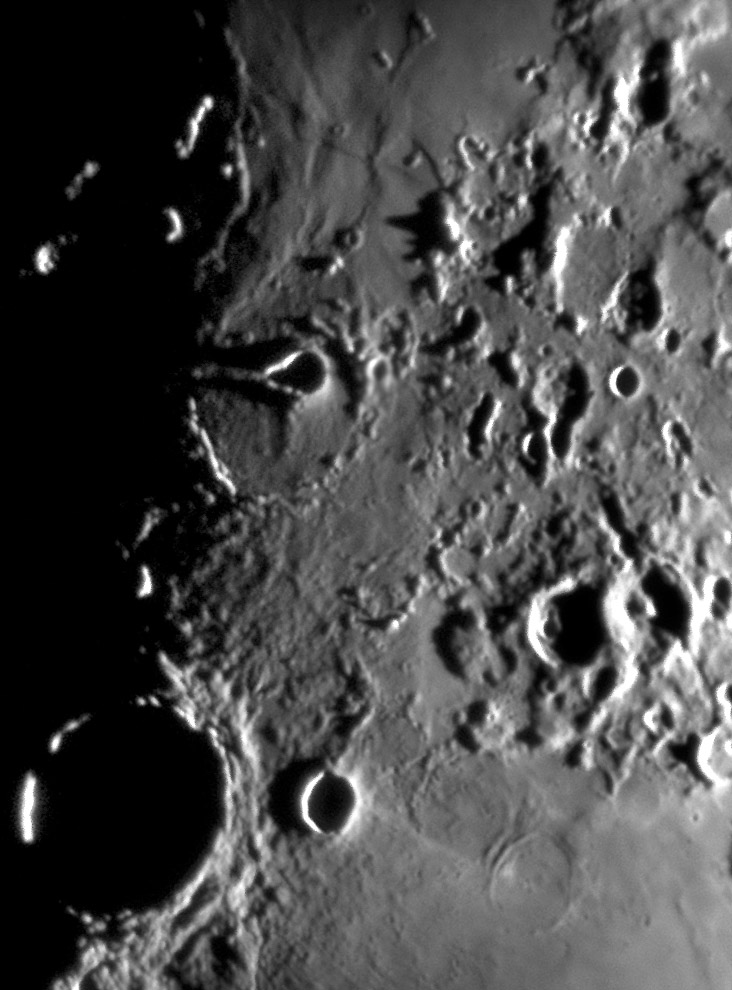April 19, 2008
New Mysteries in Familiar Territory

image by K.C. Pau, Hong Kong
Sometimes I despair of finding anything new to say about images showing familiar landforms. And then a picture like this one comes along of an area I've seen many times but showing features I hadn't noticed previously. KC's image with the first hint of sunrise on Theophilus (lower left) brings alive very subtle surface undulations in the terrain to the north. Near the top of the image the very southernmost extent of Mare Tranquillitatis lavas reach down almost to the keyhole-shaped Torricelli. About half way to Torricelli there are two to three delicate linear shadows cutting diagonally across the mare surface. These are very low features that appear to be continuations of the Hypatia Rille, which ends to the left of the bright ridge at upper left. I am not sure if these have been imaged before, or if their relation to the rille has been noted. Just south of the leftmost ridge-rille segment is a shallow elongated depression at nearly right angles. Another depression with ridged walls is just to the south, and a third one is immediately south of Torricelli. I don't know if these are related, but they are very subtle, not being hinted at in Apollo or Orbiter imagery. A third mystery is the twin shadows cast by Torricelli. This is a beautiful (and well-known) example of a ray of sunlight glaring through a low spot of a crater rim, with parallel shadows on either side. The western wall of Torricelli nearly disappears - see the Apollo 16 image - and the grazing ray of light pours through the gap. A fourth unexpected feature is the flat zone between Mädler and Isidorus. The region just west and northwest of this smooth mare patch is covered with secondaries and roughness from Theophilus. This smooth surface could be younger than Theophilus, but perhaps it was just protected from the crater's debris that nearly hugged the surface. A lot of questions for one image - I love it and eagerly await the next image that shows me something new on the Moon.
Chuck Wood
Technical Details
250mm f/6 Newtonian + new DMK31AF03 camera; processing with CS2. Lat.: 22º 15' N, Long.:114º 10' E; elevation is 0 meter.
Related Links
Rükl plates 46 & 47
Yesterday's LPOD: A Little Archimedes
Tomorrow's LPOD: Ignore the Domes
COMMENTS
(1) The time at which a lunar photo was taken can often be guessed from the lengths of the shadows (if one has something of comparable quality and timing to compare it to), but this one is even more challenging since not even the date is revealed. Perhaps that's one of today's "mysteries"? Assuming it is a recent one, I'm guessing it might have been taken this past March 12th at around 13 UT, when the Moon could have been seen from KC's location, and both the lighting and librations would have been similar to those shown here.
As to mystery #3, your description of "sunlight glaring through a low spot" on the west rim of Torricelli is quite accurate, but with all due respect to the Robinson Lunar Observatory the pattern observed is (although beautiful) neither mysterious nor due to the fanning of light pouring through a narrow crack. Although there is indeed a gap about 3 km wide in the west rim of Torricelli, the LTO shows the remainder of the rim rising out of the mare at a rather unremarkable slope of about 4 degrees. That gives a rise of roughly 1000 meters over a distance of 14 km, and the projection of that gently V-shaped rim profile onto the surface at so low an angle is completely sufficient to explain what at first glance may seem to be the spreading out of a searchlight-like beam of light. It is like having two peaks casting pyramid-shaped shadows next to each other; and even if there was no gap at all the fanning pattern would look much the same (in fact, in the absence of a gap the pattern would have an even sharper tip). It is the gently sloping rim profile that accounts for the V-shaped shadows, not the gap.
-  JimMosher
JimMosher
COMMENTS?
Register, Log in, and join in the comments.



